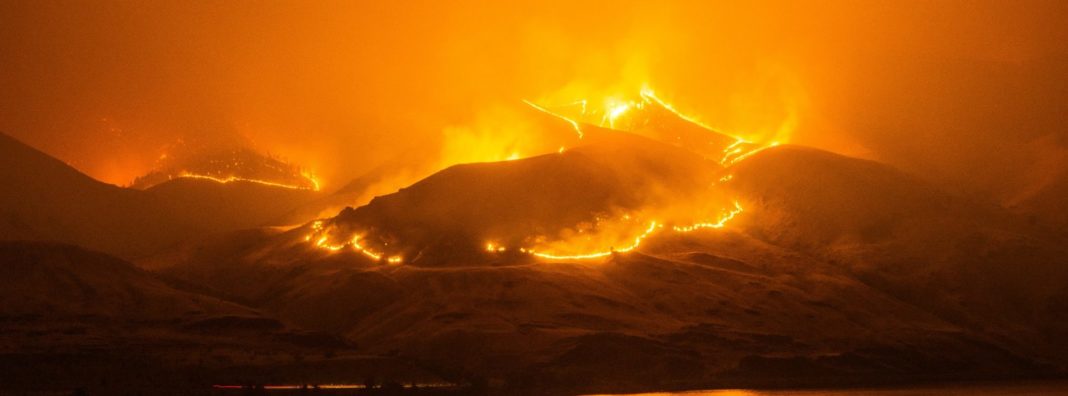
Chances are, at some point in the past few weeks, you have read or listened to news about the wildfires currently burning across Australia. Much like 2018 here in the United States, this fire season is setting records in Australia for all the wrong reasons. Australia’s fire season typically stretches from December through March but kicked off a month early this year due to higher than average temperatures and a multi-year drought. These are both worrisome problems in a country already noted for being hot and dry.
Since the beginning of November, over 12 million acres of land have burned across the country. The map of Australia below shows the number of hotspots burning at the height of the fires the week of December 18th. There has been an outpouring of public support online over the past month, with many celebrities and groups raising money to donate to stopping the fires and rehabilitating lands and animal populations once the fires die out.
Source: BBC
The support seems to stem not just from peoples’ selflessness, but also a recognition that wildfires have impacted them or someone they know. Part of this is due to historically bad fire seasons in the US in recent years and the ever-present and growing concern over climate change and what it means for the future impacts of climate events. They’re right to be concerned because there is a growing possibility the Western US could look much the same at the end of next summer, and every summer following unless we begin to address the symptoms.
That isn’t to say strides aren’t being made here at home. Policies like the Good Neighbor Authority are improving states’ ability to work with federal forest management, and innovative funding vehicles like Forest Resiliency Bonds are providing new ways to fund wildfire treatments. These are steps in the right direction, but those steps are just the first at the beginning of a marathon. The fires burning in Australia should serve as a reminder during our fire offseason that we need to continue working on ways to make our communities more fireproof and our forests more fire resilient.
Putting the Australia Fires in Perspective
So, is Australia burning at doomsday levels, and is this the point of no return for wildfire events? To give some perspective, it’s useful to compare current burns in Australia with California’s 2018 wildfire season, which was historically the most devastating fire season the state has ever had.
The 12 million acres burned so far in Australia is relatively small when compared to the total size of Australia — just over 0.6 percent of the country’s total landmass — yet still massive in terms of total land. The combined land area of Massachusetts, New Jersey, and Connecticut, for example, is roughly equal to 12 million acres. West Virginia alone is over 15 million acres.
The 2018 fire season in California, in comparison, ended with nearly 2 million acres of burned land. That is almost 2 percent of California’s total land area — meaning less total land burned in California in 2018, but a larger proportion of the state burned compared to Australia. Three times larger, in fact.
In terms of human loss of life and structural damage, the California fires in 2018 were also much, much worse. Just one fire, the Camp Fire, was responsible for the deaths of nearly 90 Californians and burned over 19,000 structures. Australia has a much lower population density than California, meaning that even where fires are burning, they are less likely to affect populations.
That isn’t to say that people have gone unaffected. So far, 27 people have been reported dead, and over 2,000 structures have been reported missing. Most of this is occurring in the southeastern states of New South Wales and Victoria, as you can see below.
Source: BBC
Where the Australian fires have been tragic is the way they have impacted wildlife. Some experts are estimating death tolls of 500 million to 1 billion animals from the fires. Most charity drives feature images of koala bears and kangaroos, native species in Australia that have been especially impacted. Images of Koalas with scorched fur are included in nearly every story about the fires.
Is it time to hit the panic button?
The scope of this year’s fire season thus far in Australia, while far outside of the norm, is not without precedent in the country. During the 2002–2003 fire season, brushfires burned over 133 million acres in Australia. According to a report for the Australian council of governments in 2004:
“Aspects of the 2002–03 fire season in south-eastern Australia were reminiscent of other seasons[…] among them 1939 in Victoria, 1961 in south-west Western Australia, 1967 in Tasmania, 1983 in Victoria and South Australia, and 1994 and 2001 in New South Wales. This pattern is a reminder that, while the 2002–03 season was severe, it was not unprecedented or even unusual in the longer sweep of history in such a fire-prone continent.”
Despite these historical precedents, Australia has been swept up into the highly politicized climate debate, with experts and activists alike pointing to the Australia fires as a harbinger of things to come if we don’t address climate change. And while the changing climate is leading to drier conditions and longer fire seasons, it is important to remember that there are steps we can take right now to lessen the severity of wildfire impacts.
Reducing the impacts of climate change is going to be a decades-long process, and we can’t afford to wait around for that to happen. If we do, we are going to see more towns like Paradise, California burning, more crucial habitat lost, and more suffering for victims of wildfires.
Thankfully, we are beginning to make some strides towards better management here in the US. Groups like Blue Forest Conservation are developing Forest Resilience Bonds, which are public-private partnerships that raise money for restoration projects meant to reduce wildfire risks. In 2018, Congress expanded authority for projects conducted under the Good Neighbor Authority, which makes it easier for state and federal forest managers to partner to improve forests. The 2018 Omnibus Bill also improved funding mechanisms for wildfire management, but it remains to be seen if it creates better incentives for forest managers.
There is still plenty of work to do. Creating well-thought-out exemptions for wildfire prevention activities such as prescribed burns under the National Environmental Policy Act and the Clean Air Act, or creating mechanisms to fast-track projects, could provide significant opportunities to make fire prevention efforts more cost-effective and timely.
As the fire season continues in Australia, let us hope that they are through the worst of it. As we continue this discourse on wildfires, climate change, and how to best adapt to changing climate conditions, we can’t afford not to take steps now to address wildfire vulnerabilities. Wildfires aren’t going to wait to see how the climate debate plays out. They are going to continue to burn regardless. We need to make sure we are prepared to deal with them.

